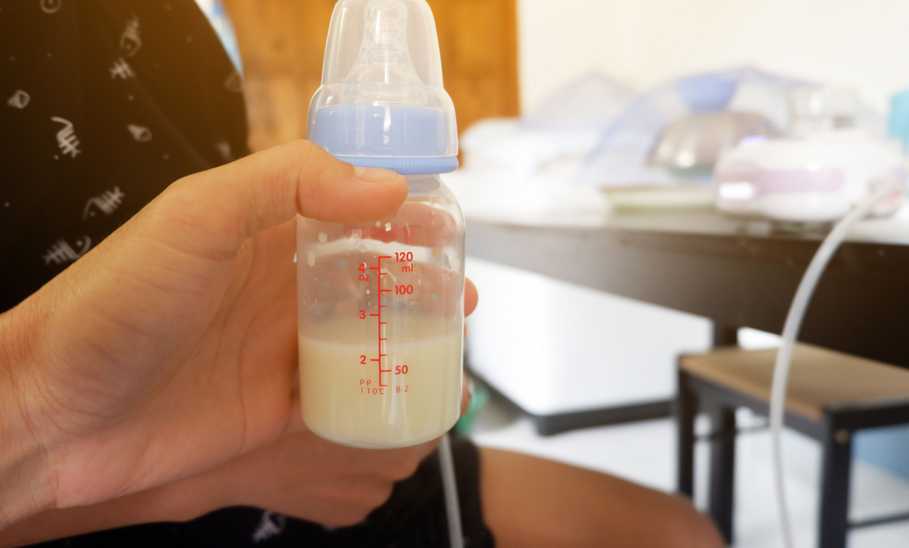How Often Should I Pump When I’m Breastfeeding?

Our evaluations and opinions are not influenced by our advertising relationships, but we may earn a commission from our partners’ links. This content is created by TIME Stamped, under TIME’s direction and produced in accordance with TIME’s editorial guidelines and overseen by TIME’s editorial staff. Learn more about it.
Breastfeeding can be a wonderful experience, but it doesn’t mean it’s not a lot of hard work. If you need or choose to add pumping along with nursing your baby, you might have even more questions and concerns. But creating a pumping routine is entirely doable; it just takes some planning.
You might have many questions about the best ways to pump and troubleshoot issues that arise. I spoke with Dr. Monica Wonnacott, MD, founder of Pediatric Answers to provide some insights into pumping and breastfeeding.
“When to start pumping depends on your situation,” explains Dr. Wonnacott. “If there’s some reason the infant can't feed immediately (or within the first hour), then pumping should be initiated right then.”
According to Dr. Wonnacott, those situations might be if you have a premature or sick baby. If you choose to and are able to breastfeed and have a healthy, full-term baby, you may not need to pump until breastfeeding has been established after the first few days.
“Pumping, in addition to breastfeeding, can help drive milk to come in faster and with larger volumes,” says Dr. Wonnacott, which is especially helpful if your baby is taking a bit longer to get the hang of nursing.
According to the Centers for Disease Control and Prevention (CDC), you should breastfeed or pump eight to 12 times in a 24-hour period. It’s normal for your newborn to want to eat every one to three hours in the first days, which can gradually stretch to every two to four hours in the initial weeks and months.
Don’t worry—it happens. You might be on a pumping schedule that’s working great for you, then something comes up, and you’ve missed your session. Don’t worry. Missing a session isn’t going to affect your milk supply, but your breasts might feel uncomfortably full. Pump when you’re able to, even if it’s not as long as your usual session. If you miss sessions frequently, that could cause a decrease in your milk supply.
If you are planning on returning to work, you might be wondering how to combine breastfeeding and pumping. Talk with your employer about a plan for providing pumping times and a private location throughout your day. According to the U.S. Department of Labor’s Fair Labor Standards Act (FLSA), you are entitled to a clean space (not a bathroom) and reasonable break times to pump.
You can store pumped milk in an employee refrigerator or bring your own cooler with ice packs. If you’re using the breakroom refrigerator, label the bottles or bags of milk with your name and store them in the back of the fridge where the temperature is most consistent.
There’s a lot to remember about pumping, so make sure you are getting your questions answered by a lactation consultant or your healthcare provider. Here are some tips to get you started.
Make sure you have the correct flange size. These are the cone-shaped pieces that fit over your nipple and part of your breast. A lactation consultant can help you find the right fit. If you aren’t using the appropriate size for your nipples, it can affect how much milk you’re able to pump.
Double pumping not only saves time instead of pumping each breast individually, but the extra stimulation helps to get more milk. This can boost your milk supply over time.
Massage both of your breasts before pumping and during the session. Research shows it can help get more milk from your breasts than if you didn’t use massage.
Looking at photos of your baby can actually help you get more milk when pumping. Snap photos of your baby nursing, or take some videos to look at later when you’re away from the baby and pumping.
Think about investing in a wearable breast pump if you’re going to be pumping over the long term. These machines can save you time by slipping the pumps into your bra and continuing with your day while collecting milk hands-free. If these pumps are out of your budget, you can buy a bra that’s designed for pumping or even cut holes in an old sports bra to make your own.
Once you’ve gotten the hang of pumping, sessions should take you 10 to 15 minutes, but it might take you longer. You can wait two or three minutes after the milk stops flowing to be sure your breasts are empty, according to Dr. Wonnacott.
“In the first few days post-birth, it’s normal to pump anywhere from a few milliliters to an ounce or two. By day three or four, most moms are pumping three to four ounces a pumping session,” says Dr. Wonnacott. She adds that as the weeks go on, you could find yourself pumping five to eight ounces per session. These amounts can vary from person to person and also depend on how long you wait between feedings.
Half an ounce to two ounces total is totally normal to pump if you’re exclusively breastfeeding and just need to pump once in a while.
Instructions for pumping will depend on the method you use. Assuming you’re using an electric breast pump, their exact instructions will vary. In general, here are the basic steps for pumping breast milk.
According to the U.S. Department of Health and Human Services, there are three ways to pump breast milk..
Hand expression is a skill that can take some time to get the hang of. But it’s good to know how to do it in case you find yourself feeling uncomfortably full and you don’t have your pump or baby with you.
Ask a lactation consultant to show you how to hand express. The CDC gives an overview with pictures on how to do it. Just make sure you wash your hands and have a clean container if you’re collecting the milk for your baby.
If you’re not planning on pumping that often but want something more than just using your hands, a small handheld pump is cost-effective and low-tech. You use your hand and wrist to pump your breasts with the device, which usually contains a collection container so you can save the milk.
Electric pumps are great if you need to pump on a more regular basis. They run on batteries or are plugged into the wall, and it’s a good idea to read over the instructions so you are familiar with the pump before you need to use it. Your lactation consultant can also help set up and understand your pump. Electric pumps typically pump both breasts at the same time, but you can use it just on one breast if you prefer. Wearable breast pumps fall into this category.
It can be hard to keep up with the safest milk storage guidelines. The CDC gives some guidance on this.
Freshly pumped milk can be left out on the counter for up to four hours before it needs to be used or stored. If your home is warm, you might want to just stick it right in the refrigerator. You can keep fresh milk in the refrigerator for up to four days or freeze it for up to one year in a deep freezer.
If you thaw frozen breast milk, it’s safe to let it sit on the counter at room temperature for one to two hours. Completely thawed breast milk is good in the refrigerator for up to 24 hours. Don’t refreeze previously frozen milk.
According to the Food and Drug Administration (FDA), you can wash your pump parts in warm water using dish soap. In fact, the plastic bins you may get from the hospital after you give birth for your supplies can make a great basin for soaking pump parts.
You don’t need to sterilize the pump parts. The FDA says you can’t even reliably sterilize these pieces at home anyway. You don’t need to clean the pump’s tubing unless breast milk gets in there, in which case you can wash it and hang it to dry. It helps to attach it back to the pump and turn it on for a few minutes to run air through the tubing.
According to Dr. Wonnacott, if you’re pumping after breastfeeding, pump until your breasts aren’t putting out more milk and then go another two to three minutes to make sure they’re empty.
“Pumping after breastfeeding is a great way to build up a milk supply both for future storage and to build your own production,” explains Dr. Wonnacott. She adds some people pump to relieve pressure, especially if you produce a lot of breast milk. “This is tricky, though, because as you increase your pumping, you end up making more milk,” Dr. Wonnacott says.
You’ll want to pump as often as your baby eats, says Dr. Wonnacott, which is usually every two to four hours.
Unless you have a reason to, such as your baby not gaining weight appropriately, most people don’t need to pump after they breastfeed. “A pediatrician will be worried about milk supply anytime the infant isn't gaining weight appropriately and is exclusively breastfeeding,” says Dr. Wonnacott.
The information presented here is created by TIME Stamped and overseen by TIME editorial staff. To learn more, see our About Us page.



